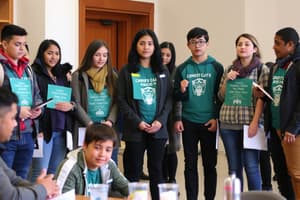Podcast
Questions and Answers
What is the main objective of the National Service Training Program?
What is the main objective of the National Service Training Program?
- To support volunteerism in non-government organizations.
- To provide military training exclusively to men.
- To foster civic consciousness and involvement among the youth. (correct)
- To prepare students for careers in law enforcement.
In which year did the Philippine Constabulary begin conducting military training at the University of the Philippines?
In which year did the Philippine Constabulary begin conducting military training at the University of the Philippines?
- 1922
- 1912 (correct)
- 1936
- 1939
Which law established the National Service Training Program for tertiary level students?
Which law established the National Service Training Program for tertiary level students?
- Republic Act 9163 (correct)
- National Defense Act
- Executive Order No. 207
- Commonwealth Act I
What significant change occurred in 1936 regarding ROTC instruction?
What significant change occurred in 1936 regarding ROTC instruction?
Who signed the National Defense Act through Executive Order No. 207?
Who signed the National Defense Act through Executive Order No. 207?
What was the first ROTC unit established in the Philippines?
What was the first ROTC unit established in the Philippines?
What is a key focus of the NSTP as stated in its objectives?
What is a key focus of the NSTP as stated in its objectives?
Which of the following statements about NSTP is false?
Which of the following statements about NSTP is false?
What primarily influences anthropogenic hazards?
What primarily influences anthropogenic hazards?
Technological hazards primarily result from what?
Technological hazards primarily result from what?
What type of hazards arise from a combination of natural and human factors?
What type of hazards arise from a combination of natural and human factors?
What does vulnerability refer to in the context of disaster risk?
What does vulnerability refer to in the context of disaster risk?
What is a significant factor in determining high disaster risk?
What is a significant factor in determining high disaster risk?
Which type of capacity includes resources such as economic and human resources?
Which type of capacity includes resources such as economic and human resources?
What may societal hazards often lead to?
What may societal hazards often lead to?
Which of the following is NOT a type of vulnerability mentioned?
Which of the following is NOT a type of vulnerability mentioned?
What is the basis of the Thomasian identity?
What is the basis of the Thomasian identity?
Which of the following best describes human dignity?
Which of the following best describes human dignity?
What role does empathy play according to the content?
What role does empathy play according to the content?
How does the intellectual and willful capacity of humans contribute to their dignity?
How does the intellectual and willful capacity of humans contribute to their dignity?
What does St. Dominic de Guzman emphasize through his founding of the Order?
What does St. Dominic de Guzman emphasize through his founding of the Order?
What is a fundamental characteristic of human beings as described in the content?
What is a fundamental characteristic of human beings as described in the content?
Which statement reflects the importance of community engagement in Thomasian ideals?
Which statement reflects the importance of community engagement in Thomasian ideals?
What is the relationship of gratitude to future hope in the context of Thomasian ideals?
What is the relationship of gratitude to future hope in the context of Thomasian ideals?
What is a key aspect of an effective community-based early warning system?
What is a key aspect of an effective community-based early warning system?
Which statement best describes the approach to community risk assessment?
Which statement best describes the approach to community risk assessment?
What does the acronym KISS stand for in the context of community planning?
What does the acronym KISS stand for in the context of community planning?
How should community-based organizations be structured for sustainability?
How should community-based organizations be structured for sustainability?
What role do methodologies like visualization and icebreakers play in community planning?
What role do methodologies like visualization and icebreakers play in community planning?
Which group is primarily targeted in hazard-specific planning?
Which group is primarily targeted in hazard-specific planning?
What is an appropriate frequency for updating community risk plans?
What is an appropriate frequency for updating community risk plans?
What is the primary focus when forming community organizations for disaster resilience?
What is the primary focus when forming community organizations for disaster resilience?
What do the Three C's of the Dominican charism represent?
What do the Three C's of the Dominican charism represent?
The charism of Order can be summarized by the phrase ‘Laudare, Benedicere, Praedicare’. What does this phrase mean?
The charism of Order can be summarized by the phrase ‘Laudare, Benedicere, Praedicare’. What does this phrase mean?
Which of the following is NOT one of the Thomasian Graduate Attributes?
Which of the following is NOT one of the Thomasian Graduate Attributes?
What is the motto of the University of Santo Tomas?
What is the motto of the University of Santo Tomas?
What aspect of man allows him to seek truth and choose good?
What aspect of man allows him to seek truth and choose good?
Who founded the University of Santo Tomas-Manila?
Who founded the University of Santo Tomas-Manila?
What does the Thomasian attribute 'Collaborator' imply?
What does the Thomasian attribute 'Collaborator' imply?
Which process does the Salamanca New World Process relate to?
Which process does the Salamanca New World Process relate to?
What factors contribute to children being less equipped to handle disasters?
What factors contribute to children being less equipped to handle disasters?
What was one consequence of the 2005 disaster in Pakistan mentioned in the content?
What was one consequence of the 2005 disaster in Pakistan mentioned in the content?
Which of the following is NOT a behavioral issue caused by disasters in children?
Which of the following is NOT a behavioral issue caused by disasters in children?
What is meant by children's resilience in the context of disasters?
What is meant by children's resilience in the context of disasters?
Which group of individuals tends to show less access to resources during a disaster?
Which group of individuals tends to show less access to resources during a disaster?
How do disasters impact the daily routines of children?
How do disasters impact the daily routines of children?
What psychological issues may arise in children due to disasters?
What psychological issues may arise in children due to disasters?
What role does exposure to violence play in the context of children experiencing disasters?
What role does exposure to violence play in the context of children experiencing disasters?
Flashcards
NSTP
NSTP
A one-year mandatory course for all freshmen in universities and colleges, mandated by Republic Act 9163.
Purpose of NSTP
Purpose of NSTP
To foster civic consciousness, nationalism, and public involvement among the youth.
Republic Act 9163
Republic Act 9163
The law that mandates the NSTP program.
NSTP's Effect
NSTP's Effect
Signup and view all the flashcards
1912 in NSTP
1912 in NSTP
Signup and view all the flashcards
1922 in NSTP
1922 in NSTP
Signup and view all the flashcards
1936 in NSTP
1936 in NSTP
Signup and view all the flashcards
1939 in NSTP
1939 in NSTP
Signup and view all the flashcards
Human Dignity
Human Dignity
Signup and view all the flashcards
Thomasian Identity Roots
Thomasian Identity Roots
Signup and view all the flashcards
Human Body and Soul
Human Body and Soul
Signup and view all the flashcards
Intellect and Will
Intellect and Will
Signup and view all the flashcards
Empathy
Empathy
Signup and view all the flashcards
St. Dominic Mission
St. Dominic Mission
Signup and view all the flashcards
Human Uniqueness
Human Uniqueness
Signup and view all the flashcards
Dignity
Dignity
Signup and view all the flashcards
Thomasian Graduate Attributes
Thomasian Graduate Attributes
Signup and view all the flashcards
Three C’s of the Dominican theological order
Three C’s of the Dominican theological order
Signup and view all the flashcards
Competence
Competence
Signup and view all the flashcards
Compassion
Compassion
Signup and view all the flashcards
Commitment
Commitment
Signup and view all the flashcards
University of Santo Tomas
University of Santo Tomas
Signup and view all the flashcards
Veritas in Caritate
Veritas in Caritate
Signup and view all the flashcards
Man's dignity
Man's dignity
Signup and view all the flashcards
Anthropogenic Hazards
Anthropogenic Hazards
Signup and view all the flashcards
Technological Hazards
Technological Hazards
Signup and view all the flashcards
Societal Hazards
Societal Hazards
Signup and view all the flashcards
Socio-Natural Hazards
Socio-Natural Hazards
Signup and view all the flashcards
Vulnerability
Vulnerability
Signup and view all the flashcards
Disaster Risk
Disaster Risk
Signup and view all the flashcards
High Disaster Risk
High Disaster Risk
Signup and view all the flashcards
Disaster
Disaster
Signup and view all the flashcards
Effective Warning System
Effective Warning System
Signup and view all the flashcards
Community Risk Assessment
Community Risk Assessment
Signup and view all the flashcards
Community Awareness, Education, and Advocacy
Community Awareness, Education, and Advocacy
Signup and view all the flashcards
Community Vulnerability
Community Vulnerability
Signup and view all the flashcards
Disaster Resilience
Disaster Resilience
Signup and view all the flashcards
Community Organizations
Community Organizations
Signup and view all the flashcards
Community-Based Strategies
Community-Based Strategies
Signup and view all the flashcards
Transparent Dissemination
Transparent Dissemination
Signup and view all the flashcards
Children in Disasters
Children in Disasters
Signup and view all the flashcards
Disaster's Impact on Children
Disaster's Impact on Children
Signup and view all the flashcards
Child Resilience
Child Resilience
Signup and view all the flashcards
Child Vulnerabilities
Child Vulnerabilities
Signup and view all the flashcards
Child's Limited Resources
Child's Limited Resources
Signup and view all the flashcards
Disasters & Behavioral Issues
Disasters & Behavioral Issues
Signup and view all the flashcards
Disaster's Long-Term Effects
Disaster's Long-Term Effects
Signup and view all the flashcards
Vulnerable Sectors in Disasters
Vulnerable Sectors in Disasters
Signup and view all the flashcards
Study Notes
National Service Training Program (NSTP)
- NSTP is a mandatory one-year course
- Required for all freshmen in universities and colleges in the Philippines
- Mandated by Republic Act 9163
- Fosters civic consciousness, nationalism, and public involvement among youth
- Enhances youth consciousness and defense preparedness through service ethics and patriotism
- Promotes active contribution to the general welfare
Quick History of NSTP
- 1912: Philippine Constabulary began military training at the University of the Philippines
- 1922: First ROTC unit established at the University of the Philippines
- 1936: Commonwealth Act 1 (National Defense Act) established a legal basis for ROTC instruction
- 1939: All ROTC units placed under the supervision of the Philippine Army
- 1944: Many ROTC graduates served in WWII
- 1980: President Marcos signed Presidential Decree No. 1706 (National Service Law), making NSTP mandatory for all citizens
NSTP Components
- Reserved-Officers' Training Corps (ROTC): Military program under the Office of Student Affairs; equips students with national defense knowledge and skills
- Civic Welfare and Training Service (CWTS): Community welfare programs under the UST Simbahayans or the Office of Community Development; enhances facilities and community welfare programs.
Good Citizenship Values
- Pagkamaka-Diyos: Faith in God, respect for life, order in work, concern for family and future generations
- Pagkamaka-Tao: Love, freedom, peace, truth, and justice
- Pagkamaka-Bayan: Unity, equality, respect for law, patriotism, and commitment to the common good
- Pagkamaka-Kalikasan: Concern for the environment
National Concerns
- Health-Related Issues:
- HIV/AIDS prevalence among children (66% of infections), incidence of death due to AIDS
- Philippine Mental Health Law (RA 11036) signed in June 2018 by President Rodrigo Duterte
- HIV/AIDS Policy Act of 2018 (RA 11166)
- **Drug Abuse:**Harmful drug use patterns impacting individuals and communities; identified risk factors include biological, psychological, and social aspects; significant familial influence.
- **Environmental Issues:**Climate change impacts on people, livestock, and agriculture; elevated temperatures due to warmer climates; high heat indexes; flooding risks.
- Disaster Risks: The Philippines is located in the Western Pacific Ring of Fire, making it prone to earthquakes, volcanic eruptions and typhoons. Other structural vulnerabilities include poverty, marginalization, inequality, climate change, and development aggression.
Other Important Notes
- The study notes provide an overview, not an exhaustive analysis of all topics
- Many more specific topics are covered within this summary encompassing the different chapters of this text.
Studying That Suits You
Use AI to generate personalized quizzes and flashcards to suit your learning preferences.




